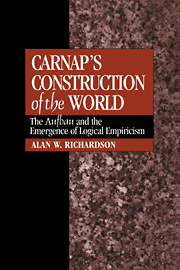Book contents
- Frontmatter
- Contents
- Acknowledgments
- Introduction
- 1 Reconstructing the Aufbau
- 2 The problem of objectivity: An overview of Carnap's constitutional project
- 3 An outline of the constitutional projects for objectivity
- 4 The background to early Carnap: Themes from Kant
- 5 The fundamentals of neo-Kantian epistemology
- 6 Carnap's neo-Kantian origins: Der Raum
- 7 Critical conventionalism
- 8 Epistemology between logic and science: The essential tension
- 9 After objectivity: Logical empiricism as philosophy of science
- Bibliography
- Index
Introduction
Published online by Cambridge University Press: 30 October 2009
- Frontmatter
- Contents
- Acknowledgments
- Introduction
- 1 Reconstructing the Aufbau
- 2 The problem of objectivity: An overview of Carnap's constitutional project
- 3 An outline of the constitutional projects for objectivity
- 4 The background to early Carnap: Themes from Kant
- 5 The fundamentals of neo-Kantian epistemology
- 6 Carnap's neo-Kantian origins: Der Raum
- 7 Critical conventionalism
- 8 Epistemology between logic and science: The essential tension
- 9 After objectivity: Logical empiricism as philosophy of science
- Bibliography
- Index
Summary
this study examines a particular portion of Rudolf Carnap's philosophical career, from a particular point of view. The period covered is roughly the fifteen years from Carnap's first publication– his 1922 dissertation, Der Raum – to the full flowering of his theory of the logical syntax of scientific language in his 1934 book, Die logische Syntax der Sprache and his seminal 1936–7 paper, “Testability and Meaning.” Although in the final chapter I speak to some central issues in the analyticity debate, I make no claim to deal with the details of Carnap's semantic period, for by the syntax period his general philosophical orientation had already been set, and those details are largely irrelevant for the story I want to tell. That is the story of Carnap's thinking about what it is to have an epistemology of empirical knowledge. The principal text for the story is Carnap's first book, Der logische Aufbau der Welt (The logical structure of the world; hereafter Aufbau). This was his most detailed and influential statement of a project in general epistemology. It contrasts both with the methodological focus of his earliest essays and with the rejection of epistemology that marks his syntax period.
The account given is somewhat novel. It rejects the easy assimilation of Carnap's epistemological views to those of Bertrand Russell's “external world program.” This rejection is guided by contextual and historiographic concerns. The Russellian perspective fails to engage with the text of the Aufbau in anything like its own terms. Rather, it imposes on it a philosophical perspective concerning epistemology that stands quite at odds with Carnap's own views of what epistemology is and what it is for.
- Type
- Chapter
- Information
- Carnap's Construction of the WorldThe Aufbau and the Emergence of Logical Empiricism, pp. 1 - 4Publisher: Cambridge University PressPrint publication year: 1997



